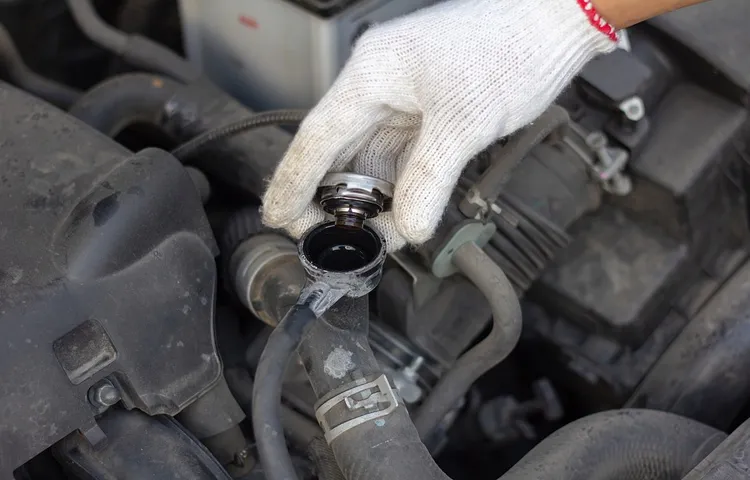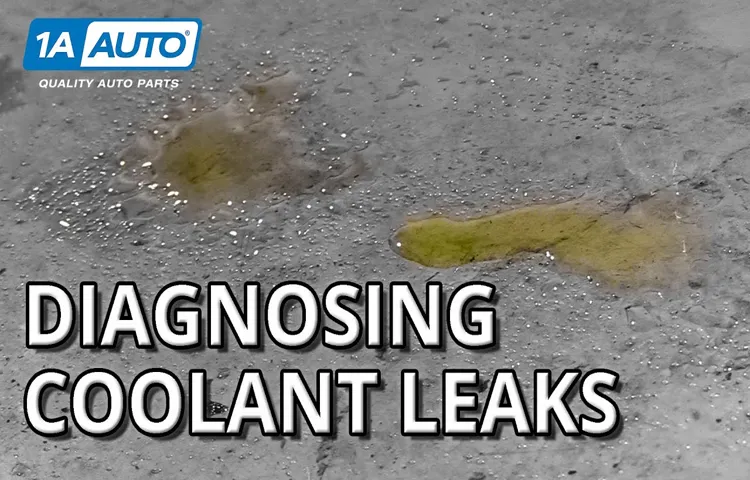If you own a car, chances are you’ve dealt with a coolant leak at some point in your driving career. It’s a common issue that can be caused by several factors, and it’s important to address it promptly before it leads to more significant problems. But what exactly causes coolant leaks? Is it something you can prevent, or is it simply a matter of wear and tear? To put it simply, coolant leaks occur when the coolant, which is responsible for keeping your engine from overheating, is escaping from its intended pathway.
Some of the common causes of coolant leaks include worn or damaged hoses, a damaged radiator, a faulty water pump or thermostat, a damaged head gasket or engine block, or even just a loose or damaged radiator cap. In some cases, these issues can be prevented through regular maintenance, such as checking and replacing worn hoses, checking the radiator for damage, and ensuring the water pump is working correctly. However, in other cases, these issues may simply be a result of regular wear and tear on your vehicle.
If you suspect a coolant leak, you should take your car to a mechanic as soon as possible. Ignoring the issue can lead to overheating, engine damage, and even complete engine failure. By addressing the problem early on, you can save yourself money and hassle in the long run.
In conclusion, while coolant leaks can be a bit of a headache, they’re a common issue that can be dealt with fairly easily. By understanding what causes them and taking preventative measures where possible, you can keep your car running smoothly for years to come.
Table of Contents
Degradation of Gaskets and Seals
When it comes to coolant leaks, the degradation of gaskets and seals is a common culprit. Gaskets and seals are components that serve as barriers within the engine, preventing the leakage of fluids. However, over time, the constant exposure to temperature fluctuations and chemical reactions can cause them to wear down, crack, or break.
This degradation can eventually lead to a coolant leak. Coolant is responsible for regulating engine temperatures, so if it begins to leak, it can be a serious problem. A coolant leak can cause an engine to overheat, and if left untreated, can cause severe damage.
The best way to prevent a coolant leak from happening is to have your gaskets and seals checked regularly by a professional mechanic. If any signs of degradation are detected, it is best to have them replaced promptly before they can cause any major problems.
Heat and Pressure
Heat and Pressure Gaskets and seals are vital components of various machines as they work to keep fluids and gases inside. However, degradation of gaskets and seals can occur due to the effects of heat and pressure. When exposed to high temperatures, seals and gaskets can lose elasticity, become brittle, and eventually crack, leading to leaks and failure.
High-pressure situations can also cause gaskets to fail, as excess pressure can cause them to deform and lose their sealing properties. To ensure the longevity of seals and gaskets in machinery, it is important to choose materials that can withstand high temperatures and pressure. Additionally, regular maintenance and replacement can help prevent failures due to degradation.
It’s important to pay attention to the functioning of gaskets and seals to ensure safety and efficiency in machines.

Chemical Contamination
Chemical contamination can cause significant damage to industrial equipment, especially gaskets and seals. Over time, this can lead to degradation and failure of the sealing components. When exposed to chemicals or processes involving aggressive media and temperatures, gaskets and seals can swell, harden, or crack, leading to leaks and equipment failure.
Chemicals like acids, oils, and alkalis can corrode the gasket’s surface, making it more sensitive to vibration, erosion, and mechanical stress. This can result in reduced performance and system efficiency, loss of product or personnel safety issues. It’s important to choose gasket and sealing materials that are resistant to the specific chemicals they will come into contact with and avoid incompatible materials.
Regular inspection, maintenance, and replacements of gaskets and seals can help ensure system reliability in the face of chemical contamination.
Damage to the Radiator or Hoses
Coolant leaks typically occur due to damage to the radiator or hoses. Over time, these components can wear out, crack, or even completely break, leading to coolant leaks. In some cases, corrosion or rust can also contribute to damage.
When the radiator or hoses are damaged, the coolant can escape and cause engine overheating, which can further damage engine components. It’s important to regularly inspect these parts and replace any damaged components immediately to prevent costly engine repairs. If you notice any coolant leaks, be sure to take your vehicle to a trusted mechanic to have the issue addressed promptly.
By staying vigilant and addressing any issues promptly, you can help keep your engine running smoothly and avoid more significant problems down the road.
Road Debris and Collisions
Road debris can cause serious damage to your vehicle, including the radiator or hoses. Collisions with rocks, tree branches, or other debris can puncture or crack the radiator, leading to leaks that can cause engine overheating or even complete failure. In addition, impact with debris can cause damage to the hoses, causing them to split or detach, leading to coolant loss.
It’s crucial to regularly inspect your vehicle for any signs of damage to the radiator or hoses, as catching any issues early can prevent costly repairs down the road. If you notice any warning signs such as engine overheating, low coolant levels, or visible damage to the radiator or hoses, it’s important to take your vehicle in for inspection and repair immediately. Don’t let road debris put a dent in your driving experience – stay vigilant and proactive to keep your car running smoothly.
General Wear and Tear
Over time, the radiator and hoses in your vehicle can become damaged due to general wear and tear. This can lead to leaks and other issues that can affect the performance and safety of your car. The radiator is the heart of your vehicle’s cooling system and is responsible for keeping the engine at the right temperature.
It is common for the radiator to develop leaks, especially if it is not properly maintained. Hoses can also become damaged or worn over time, leading to leaks and other issues. Signs of radiator and hose damage include overheating, low coolant levels, and leaks.
If you notice any of these issues, it is important to have them addressed as soon as possible to prevent further damage to your vehicle. Proper maintenance and regular inspections can help prevent radiator and hose damage and ensure that your vehicle remains in good working condition.
Overheating
Overheating of the engine can lead to severe damage to the radiator or hoses of your vehicle. When the engine overheats, it can cause the coolant to boil and create pressure within the radiator. This pressure might cause the radiator or the hoses connected to it to burst.
If the vehicle continues to run with an overheated engine, it can lead to severe damage to other parts of the engine, including the head gasket. This can be expensive to repair, and in some cases, the damage may be irreparable. Therefore, it is essential to keep an eye on your engine’s temperature gauge regularly and take immediate action if it starts to overheat.
This may include pulling over and letting your engine cool down or calling for professional assistance. To prevent overheating, ensure that your cooling system is in good condition, and always remember to keep your coolant levels topped up.
Symptoms of a Coolant Leak
A coolant leak can happen for a variety of reasons, and it’s important to identify the symptoms early on to avoid more serious issues. One of the most significant symptoms is overheating. If you notice your engine temperature gauge rising or steam coming from under the hood, it could be a sign of a coolant leak.
Another symptom is a sweet smell coming from the engine. This indicates that the coolant is leaking and being burnt off. The coolant level may also decrease, which can cause the engine to run hot and eventually lead to damage.
If you see a puddle of green, pink, or yellow fluid under your car, it’s time to take action. There are many potential causes of coolant leaks, including a faulty radiator, thermostat, or water pump, or even just a loose hose. Regular maintenance and inspections can help detect and prevent coolant leaks, ultimately ensuring the longevity and performance of your vehicle.
Engine Overheating
Engine overheating is a common problem faced by many vehicle owners, and it can be caused by various issues, including a coolant leak. The coolant is an essential component of the engine cooling system, and it regulates the temperature to prevent overheating. However, when there is a leak, the coolant levels drop, and the engine may overheat.
Some of the common symptoms of a coolant leak include a sweet smell from the engine compartment, visible coolant dripping underneath the vehicle, and an engine temperature gauge reading higher than normal. If you notice any of these signs, it is crucial to address the issue promptly to avoid severe engine damage. A professional mechanic can diagnose and fix the coolant leak, possibly saving you from costly repairs down the line.
Always remember that prevention is better than cure, and regular vehicle maintenance can help prevent coolant leaks and overheating.
Low Coolant Levels
Low coolant levels are a common issue that can be caused by a coolant leak. If you’re experiencing low coolant levels, it’s important to look for symptoms of a leak in order to catch it early and prevent further damage to your engine. Some of the most common symptoms of a coolant leak include a sweet smell coming from the engine, an overheating engine, white smoke coming from the exhaust pipe, and coolant puddles under your parked car.
If you notice any of these symptoms, it’s important to take your car to a mechanic as soon as possible to have it inspected and repaired. Driving with low coolant levels can cause your engine to overheat, which can lead to costly repairs down the line. Don’t overlook the importance of maintaining proper coolant levels in your car to keep it running smoothly and efficiently.
Preventing Coolant Leaks
Coolant leaks can happen for several reasons, but the most common cause is typically due to a damaged or worn-out part. The radiator, hoses, gaskets, and water pump are all essential components of a vehicle’s cooling system. Over time, these parts can become corroded, cracked, or simply worn out, which can lead to a leak.
Additionally, extreme fluctuations in temperature and pressure can also contribute to a coolant leak. For instance, when the engine overheats, the metal parts can expand and contract rapidly, causing small cracks to form in the engine block or cylinder head. These cracks can then lead to a coolant leak.
Regular maintenance, inspections, and replacing damaged parts as soon as possible are some of the best ways to prevent coolant leaks from occurring. Simple procedures like checking the coolant level and monitoring the temperature gauge can also help detect any underlying issues before they become serious.
Conclusion
In the battle of hot versus cold, your engine could be the ultimate casualty. When a coolant leak happens, it’s like a rift between worlds: the internal heat and external chill clash in the form of a spewing liquid. The culprit might be a loose fitting, a cracked hose, or any number of malfunctions within the cooling system.
In any case, it’s a leaky mess that can cause overheating, engine damage, and headaches galore. So, take care of your car’s coolant system and make sure it stays in tip-top shape. Because when it comes to keeping your engine cool, prevention is always cooler than a major meltdown.
“
FAQs
What are the common causes of a coolant leak in a vehicle?
The common causes of a coolant leak in a vehicle include a damaged radiator, a faulty water pump, a cracked engine block, or a damaged hose.
Can a coolant leak cause engine damage?
Yes, a coolant leak can cause engine damage if left unaddressed. A lack of coolant can cause the engine to overheat, resulting in potential damage to the engine.
How can a driver detect a coolant leak?
Drivers can detect a coolant leak by checking the coolant level regularly, looking for visible signs of leaking, such as puddles of fluid under the vehicle, and watching for warning lights on the dashboard.
Is it safe to drive a vehicle with a coolant leak?
It is not safe to drive a vehicle with a coolant leak as it can cause overheating and potential engine damage. In addition, leaking coolant can pose a hazard to the environment.
How can a coolant leak be repaired?
The best way to repair a coolant leak is to identify the source and replace the damaged component. This may involve replacing a radiator, water pump, or hoses. It is important to address a coolant leak promptly to prevent further damage to the engine.
What is the cost of repairing a coolant leak?
The cost of repairing a coolant leak can vary greatly depending on the source of the leak and the extent of the damage. Repairs can range from a few hundred dollars to several thousand dollars.
Can preventative maintenance help prevent coolant leaks?
Yes, preventative maintenance can help prevent coolant leaks. Regularly checking the coolant level, inspecting hoses and connections, and replacing coolant according to the manufacturer’s recommendations can help identify and prevent leaks before they occur.



